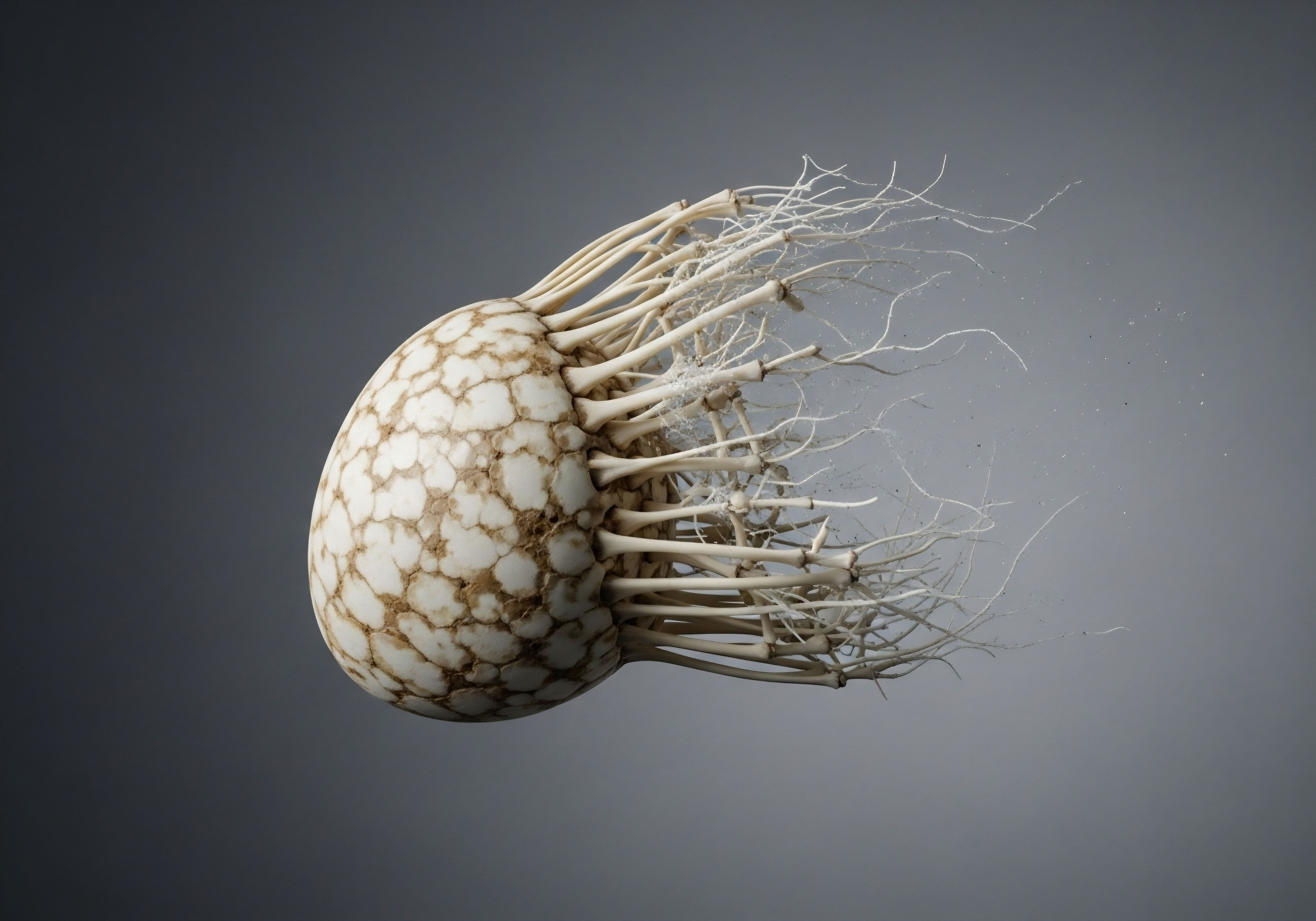

Fundamentals
Experiencing changes in your hair, whether it is a subtle thinning at the temples or a more noticeable reduction in overall density, can bring about a sense of unease. This experience often prompts questions about what is truly happening within your body.
It is a common human experience, one that many individuals navigate, and it frequently points to shifts in the intricate balance of your internal systems. Understanding these biological processes can transform a feeling of helplessness into a clear path toward reclaiming vitality and function.
At the heart of many hair changes, particularly those involving a gradual reduction in hair shaft diameter, lies a process known as hair follicle miniaturization. This phenomenon is a hallmark of androgenetic alopecia, a condition that affects millions globally. Imagine your hair follicles, those tiny organs beneath your skin responsible for producing each strand, as miniature factories.
In a healthy state, these factories operate robustly, generating thick, long, and pigmented hairs. When miniaturization begins, these factories start to shrink, producing progressively finer, shorter, and lighter hairs until, in some instances, they cease production altogether.
Hair follicle miniaturization represents a gradual shrinking of the hair-producing structures, leading to thinner, shorter hair.
The primary biological mechanism driving this miniaturization involves a specific class of hormones known as androgens. These powerful signaling molecules play a significant role in various bodily functions, from muscle development to reproductive health. Among the androgens, testosterone is widely recognized. However, within the hair follicle itself, another androgen, dihydrotestosterone (DHT), often exerts a more potent influence. DHT is a derivative of testosterone, created through a specific biochemical conversion.
This conversion is facilitated by an enzyme called 5-alpha-reductase. Think of 5-alpha-reductase as a biological catalyst, a specialized protein that speeds up a particular chemical reaction. In this context, its role is to transform testosterone into DHT.
The presence and activity of this enzyme within the hair follicle determine how much testosterone is converted into its more potent counterpart. High levels of DHT, particularly in genetically predisposed hair follicles, can bind to specific receptors on the hair follicle cells. This binding initiates a cascade of events that ultimately leads to the shrinking of the follicle and the shortening of its growth cycle.

Understanding the Hair Growth Cycle
To appreciate the impact of 5-alpha-reductase and DHT, it helps to consider the natural hair growth cycle. Hair growth is not a continuous process; instead, it occurs in distinct phases:
- Anagen Phase ∞ This is the active growth phase, where hair cells rapidly divide, and the hair shaft lengthens. This phase can last for several years.
- Catagen Phase ∞ A brief transitional phase where hair growth stops, and the follicle prepares for the resting phase.
- Telogen Phase ∞ The resting phase, during which the hair remains in the follicle but does not grow. At the end of this phase, the hair sheds.
- Exogen Phase ∞ The active shedding of old hairs, often considered part of the telogen phase.
In androgenetic alopecia, the influence of DHT, mediated by 5-alpha-reductase, significantly shortens the anagen phase. This means hairs spend less time growing and more time in the resting or shedding phases. Over successive cycles, the hair follicles produce progressively thinner and shorter hairs, eventually becoming almost invisible or ceasing production entirely. This shift from robust, terminal hairs to fine, vellus-like hairs is the visual manifestation of miniaturization.

The Genetic Blueprint and Hormonal Sensitivity
The susceptibility of hair follicles to DHT is not universal across the scalp or among individuals. Certain areas, such as the crown and temples, are typically more vulnerable to miniaturization, while hair at the back and sides of the head often remains unaffected.
This regional difference is attributed to variations in the concentration of 5-alpha-reductase and the sensitivity of androgen receptors within the hair follicles themselves. Individuals inherit genetic predispositions that influence how their hair follicles respond to circulating androgens.
A person’s genetic makeup can dictate the number and activity of androgen receptors on hair follicle cells, as well as the local activity of 5-alpha-reductase enzymes. This explains why some individuals experience significant hair thinning, even with what are considered normal circulating levels of testosterone, while others maintain a full head of hair despite higher androgen levels. The interaction between your unique genetic blueprint and your endocrine system creates a personalized landscape for hair health.


Intermediate
Moving beyond the foundational understanding, we can now explore the specific enzymatic players and clinical strategies that address hair follicle miniaturization. The enzyme 5-alpha-reductase, while often discussed as a singular entity, actually exists in different forms, or isoforms, each with distinct characteristics and tissue distribution. Understanding these isoforms is central to appreciating the targeted nature of certain therapeutic interventions.

Isoforms of 5-Alpha-Reductase
There are three primary isoforms of 5-alpha-reductase that have been identified in human tissues:
- Type 1 5-alpha-reductase ∞ This isoform is widely distributed throughout the body, with significant presence in sebaceous glands, liver, and skin, including the scalp. It plays a role in overall DHT production.
- Type 2 5-alpha-reductase ∞ Predominantly found in the prostate, seminal vesicles, and, critically, in the dermal papilla cells of hair follicles on the scalp. This isoform is considered the primary driver of DHT production in the scalp and is highly implicated in androgenetic alopecia.
- Type 3 5-alpha-reductase ∞ While less studied than Types 1 and 2, this isoform is also present in various tissues, including the brain and skin, and contributes to DHT synthesis.
The differential expression of these isoforms explains why certain medications are more effective for specific conditions. For instance, the hair follicles susceptible to miniaturization in androgenetic alopecia exhibit elevated levels of Type 2 5-alpha-reductase. This localized increase in enzymatic activity leads to a higher concentration of DHT within these specific follicles, even if systemic testosterone levels are within a typical range.
Different 5-alpha-reductase isoforms exhibit varied tissue distribution, influencing localized DHT production and hair follicle response.

Targeting 5-Alpha-Reductase Activity
Given the central role of DHT in hair follicle miniaturization, clinical protocols often focus on modulating the activity of 5-alpha-reductase. Medications known as 5-alpha-reductase inhibitors (5-ARIs) are designed to reduce the conversion of testosterone to DHT. The two most commonly utilized agents in this class are finasteride and dutasteride.
Finasteride primarily inhibits Type 2 5-alpha-reductase. By blocking this specific isoform, finasteride significantly reduces DHT levels in the scalp, thereby mitigating its detrimental effects on susceptible hair follicles. This action helps to slow or halt the progression of hair loss and, in many cases, can lead to a reversal of miniaturization and an increase in hair density.
Dutasteride offers a broader spectrum of inhibition, targeting both Type 1 and Type 2 5-alpha-reductase isoforms. This dual inhibition results in a more substantial reduction in systemic and localized DHT levels compared to finasteride. Clinical studies indicate that dutasteride may be more effective in stimulating hair regrowth and reversing miniaturization, particularly in individuals who may have higher Type 1 activity or require a more comprehensive DHT reduction.

Clinical Considerations for 5-ARI Therapy
When considering 5-ARI therapy, a personalized approach is paramount. Factors such as the extent of hair loss, individual response, and potential systemic effects are carefully evaluated. These medications are typically administered orally, with specific dosing protocols tailored to the individual’s needs.
For men experiencing androgenetic alopecia, a standard protocol for finasteride often involves a daily oral tablet. For dutasteride, a lower daily dosage is typically prescribed due to its greater potency and longer half-life. It is important to recognize that the benefits of these treatments are generally sustained only with continued use. Discontinuation can lead to a return of hair loss.
The impact of 5-ARIs extends beyond hair health. Given their systemic action on DHT, these medications are also utilized in the management of benign prostatic hyperplasia (BPH), a condition characterized by prostate enlargement. This highlights the interconnectedness of hormonal pathways across different bodily systems.
The following table provides a comparative overview of finasteride and dutasteride:
| Characteristic | Finasteride | Dutasteride |
|---|---|---|
| Primary Isoform Inhibition | Type 2 5-alpha-reductase | Type 1 and Type 2 5-alpha-reductase |
| DHT Reduction (Scalp) | Significant | More substantial |
| DHT Reduction (Systemic) | Approximately 70% | Approximately 90% or more |
| Typical Dosage (AGA) | 1 mg daily | 0.5 mg daily |
| Half-Life | Shorter (approx. 6-8 hours) | Longer (approx. 5 weeks) |
| Hair Regrowth Potential | Effective | Potentially more effective |

Connecting to Broader Hormonal Balance
While 5-alpha-reductase and DHT are central to hair follicle miniaturization, it is vital to consider the broader endocrine system. Hormones operate as a complex orchestra, with each signaling molecule influencing others. For instance, in men undergoing Testosterone Replacement Therapy (TRT), the introduction of exogenous testosterone can lead to an increase in circulating testosterone levels.
This, in turn, can provide more substrate for 5-alpha-reductase, potentially increasing DHT levels. Therefore, a comprehensive TRT protocol often includes agents like Anastrozole to manage estrogen conversion, and sometimes 5-ARIs are considered to address potential hair-related concerns for those susceptible.
For women, hormonal balance is equally intricate. Conditions such as Polycystic Ovary Syndrome (PCOS) can lead to elevated androgen levels, contributing to hair thinning on the scalp alongside other symptoms. In these cases, addressing the underlying hormonal dysregulation is paramount, and 5-ARIs may be part of a broader therapeutic strategy. The interplay of estrogens, thyroid hormones, and even stress hormones like cortisol can also influence hair cycle dynamics, underscoring the need for a holistic assessment of hormonal health.


Academic
To truly grasp the intricate dance between 5-alpha-reductase and hair follicle miniaturization, we must delve into the molecular and cellular underpinnings, exploring the systems-biology perspective that reveals the profound interconnectedness of physiological processes. The pathogenesis of androgenetic alopecia extends beyond simple enzyme activity, encompassing genetic predispositions, cellular signaling pathways, and the broader metabolic milieu.

Molecular Signaling in Hair Follicle Miniaturization
The core event in androgenetic alopecia is the aberrant response of genetically susceptible hair follicles to dihydrotestosterone. This response is mediated by the androgen receptor (AR), a protein located within the cells of the hair follicle, particularly in the dermal papilla. DHT binds to these ARs with a significantly higher affinity than testosterone, initiating a cascade of gene expression changes.
The binding of DHT to the AR triggers the activation of specific genes that promote hair follicle miniaturization. While the precise molecular mechanisms are still under active investigation, research indicates that DHT-AR complex activation can influence various signaling pathways crucial for hair growth.
For instance, studies suggest that DHT can suppress the canonical Wnt/β-catenin signaling pathway, which is vital for hair follicle development and the anagen growth phase. Conversely, DHT may stimulate the expression of inhibitory factors, such as dickkopf 1 (DKK-1), which further antagonize Wnt signaling, leading to a shortened anagen phase and the production of smaller, vellus-like hairs.
DHT’s influence on hair follicle miniaturization involves complex molecular signaling, including the suppression of vital growth pathways.
Furthermore, the expression levels of 5-alpha-reductase isoforms and androgen receptors are not static; they can be influenced by genetic variations. Polymorphisms in the Androgen Receptor gene (AR gene) can lead to variations in receptor sensitivity or number, making some individuals’ hair follicles inherently more responsive to DHT, even at normal circulating concentrations. This genetic component explains the strong familial aggregation observed in androgenetic alopecia.

Why Do Some Hair Follicles Miniaturize While Others Do Not?
The paradox of androgen action ∞ where DHT promotes hair growth in some areas (e.g. beard, body hair) but causes loss on the scalp ∞ is a fascinating aspect of hair biology. This differential response is attributed to a complex interplay of factors, including:
- Regional Differences in 5-alpha-reductase Activity ∞ Scalp hair follicles, particularly those in the androgen-sensitive regions (vertex, frontal), tend to have higher levels of Type 2 5-alpha-reductase activity compared to other areas or non-balding regions.
- Androgen Receptor Density and Sensitivity ∞ The number and sensitivity of androgen receptors vary across different hair follicles. Scalp follicles prone to miniaturization often exhibit increased androgen receptor expression.
- Local Growth Factor and Cytokine Milieu ∞ The microenvironment of the hair follicle, including the presence of various growth factors and cytokines, also plays a role. DHT’s effects are modulated by these local signaling molecules, which can differ significantly between scalp regions.
- Aromatase Activity ∞ The enzyme aromatase converts androgens (like testosterone) into estrogens. High aromatase activity, often found in the occipital (back of the head) scalp, can reduce local androgen concentrations, thereby protecting those follicles from DHT-induced miniaturization.
This intricate balance of enzymes and receptors within each hair follicle determines its ultimate fate in the presence of androgens.

Systemic Interconnections and Metabolic Health
While 5-alpha-reductase and DHT are direct players in hair follicle miniaturization, a truly comprehensive understanding requires acknowledging the broader systemic context. Hormonal health is inextricably linked to metabolic function, inflammation, and overall physiological balance.
For instance, conditions associated with metabolic dysregulation, such as insulin resistance and metabolic syndrome, can influence androgen metabolism. Insulin resistance can lead to increased ovarian or adrenal androgen production in women, contributing to hyperandrogenism and subsequent hair thinning. In men, metabolic imbalances can affect the delicate equilibrium of the hypothalamic-pituitary-gonadal (HPG) axis, indirectly impacting testosterone and DHT levels.
Chronic low-grade inflammation, a common feature of metabolic dysfunction, can also contribute to hair loss by creating an unfavorable environment for hair follicle health. Inflammatory cytokines can disrupt the hair cycle and exacerbate the miniaturization process. Therefore, addressing systemic inflammation and optimizing metabolic health through lifestyle interventions and targeted nutritional support can be complementary strategies in managing hair thinning.

How Do Personalized Wellness Protocols Address Hair Health?
Personalized wellness protocols, such as those involving Testosterone Replacement Therapy (TRT) or Growth Hormone Peptide Therapy, consider the entire physiological landscape. When optimizing hormonal levels, a skilled practitioner accounts for potential downstream effects, including those on hair follicles.
For men on TRT, while the primary goal is to restore optimal testosterone levels for vitality, muscle mass, and cognitive function, the potential for increased DHT conversion is a consideration. Protocols may include strategies to mitigate this, such as monitoring DHT levels and, if necessary, incorporating a 5-ARI or other supportive agents. The aim is to achieve systemic hormonal balance without compromising hair health.
Similarly, in women, hormonal optimization protocols, including low-dose testosterone or progesterone therapy, are carefully calibrated to support overall well-being while minimizing androgenic side effects. The focus remains on restoring physiological harmony, recognizing that hair health is a reflection of deeper systemic balance.
The table below illustrates how various hormonal and metabolic factors can influence hair health:
| Factor | Influence on Hair Health | Relevance to 5-alpha-reductase |
|---|---|---|
| Androgens (Testosterone, DHT) | Primary drivers of androgenetic alopecia and miniaturization. | DHT is a direct product of 5-alpha-reductase activity. |
| Estrogens | Generally protective; higher levels associated with prolonged anagen phase. | Aromatase, an enzyme that competes with 5-alpha-reductase for androgen substrates, converts androgens to estrogens. |
| Thyroid Hormones | Crucial for hair cycle regulation; dysregulation can cause diffuse hair loss. | Indirect influence on overall metabolic rate and cellular function, which can impact enzyme activity. |
| Insulin Resistance | Can increase androgen production, particularly in women (PCOS). | Indirectly influences substrate availability for 5-alpha-reductase. |
| Chronic Inflammation | Can disrupt hair cycle and exacerbate miniaturization. | Creates an unfavorable cellular environment that can impact enzyme and receptor function. |
The sophisticated understanding of 5-alpha-reductase’s role extends beyond its direct enzymatic action to encompass its place within a vast network of biological interactions. This perspective empowers individuals to approach hair health not as an isolated concern, but as an integral component of their overall physiological well-being.

References
- Ellis, J. A. Stebbing, M. & Harrap, S. B. (2001). Genetic analysis of male pattern baldness and the 5alpha-reductase type 2 gene. Journal of Investigative Dermatology, 116(3), 409-412.
- Kaufman, K. D. (2002). Androgen metabolism in hair follicles. Experimental Gerontology, 37(8-9), 981-990.
- Price, V. H. (1999). Androgenetic alopecia in women. Journal of Investigative Dermatology Symposium Proceedings, 4(3), 343-348.
- Sinclair, R. D. (2004). Male pattern hair loss ∞ a clinical review. Medical Journal of Australia, 181(8), 441-445.
- Urysiak, M. & Kmieć, M. L. (2024). The Hormonal Background of Hair Loss in Non-Scarring Alopecias. International Journal of Molecular Sciences, 25(5), 2950.
- Zhou, J. et al. (2023). The AR/miR-221/IGF-1 pathway mediates the pathogenesis of androgenetic alopecia. International Journal of Biological Sciences, 19(11), 3307-3323.
- Midorikawa, T. et al. (2018). Increased androgen levels result in a negative feedback of gene expression of the Notch pathway, leading to miniaturization of the hair follicle and overexpression of the AR gene. Journal of Dermatological Science, 91(1), 10-18.
- Olsen, E. A. et al. (2006). The importance of 5alpha-reductase in the pathogenesis of androgenetic alopecia. Journal of the American Academy of Dermatology, 55(6), 1014-1019.
- Rossi, A. et al. (2012). Finasteride and dutasteride in the treatment of androgenetic alopecia ∞ a review of the literature. Dermatology Research and Practice, 2012, 708420.
- Imperato-McGinley, J. et al. (1974). Male pseudohermaphroditism with 5alpha-reductase deficiency. The New England Journal of Medicine, 291(25), 1279-1282.

Reflection
The journey to understanding your body’s systems, particularly something as seemingly localized as hair thinning, reveals a much grander design. We have explored how a single enzyme, 5-alpha-reductase, stands at a critical crossroads in hormonal metabolism, influencing not only hair follicles but also broader physiological landscapes. This knowledge is not merely academic; it is a lens through which you can view your own experiences with greater clarity and purpose.
Recognizing the intricate interplay of genetics, hormones, and metabolic health empowers you to move beyond surface-level concerns. It invites a deeper inquiry into your unique biological blueprint. The path to reclaiming vitality and optimal function is always a personal one, shaped by individual needs and responses. This understanding serves as a foundational step, guiding you toward informed conversations with healthcare professionals and the development of truly personalized wellness protocols.
Consider this exploration a beginning, an invitation to listen more intently to your body’s signals and to seek solutions that honor its inherent complexity. Your well-being is a dynamic process, and with knowledge as your guide, you possess the capacity to navigate it with confidence and precision.



